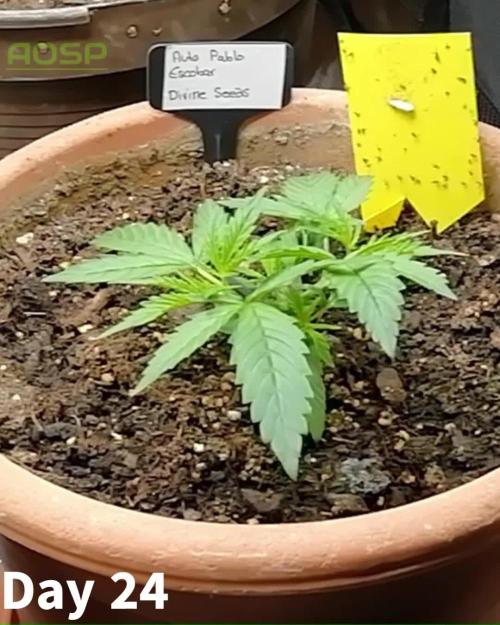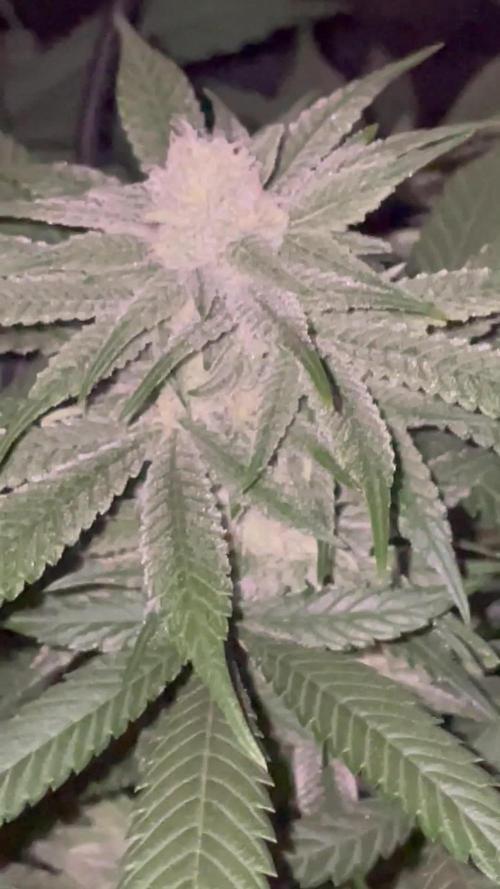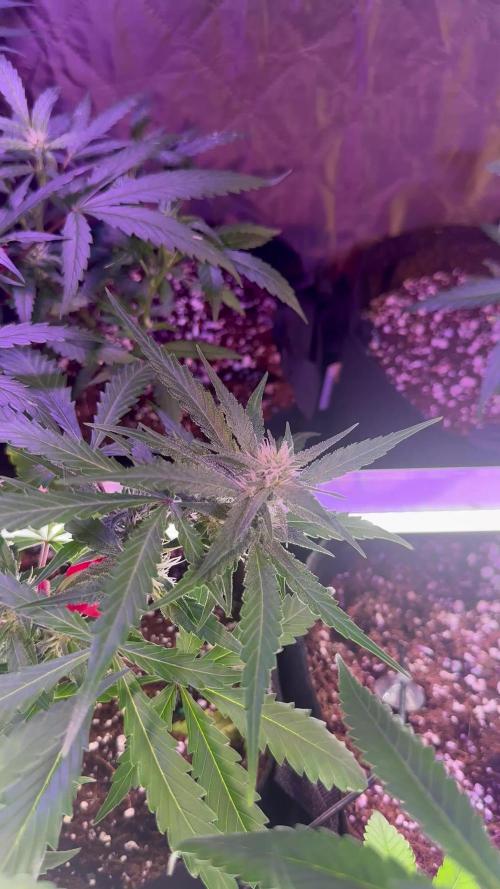The Grow Awards 2026 🏆 

























Likes
Comments
Share


@Organic473
Follow
Another Hurricane Beryl Survivor. I will let her dry out for a few days and add come charcoal with molasses for the buds.
Likes
16
Share


@Rando1314
Follow
I’m quite surprised as to how well these girls are looking and smelling!! They’re quality genetics but i also believe every strain will provide pros and cons during the grow. This one particularity has been quite the learning experience. Cannabis is quite the resilient plant and I definitely like growing them. As far as this week goes they’re definitely producing more trichomes and resin glands and appears there’s no more stretch from the plant. No more new growth even small amounts hidden within the canopy. I did a little flush earlier this week and it made the tips of what fan leaves turn yellowish so it def means we’re getting close to the end. Prob got another 2 weeks before I fully flush for Atleast a week then pulling them down. The trichs will be the ultimate deciding factor. I’ll pull when i see the first sign as I like more of a heady high than a couch-lock with little to none clear. Well till next week y’all happy growin and hopefully ya had a good thanksgiving
Likes
19
Share


@Tmasm
Follow
Saudações.
Bem melhor planta do ano no meu jardim. Voltei plantar no futuro, sem dúvida.
Bem chegou o grande dia, cortei minha menina. Ela tem botões tão lindos que até me custou um pouco cortar.
Na sala tinha ácaros aranha, mas menina não foi afetada. Adicionei luz UV-C para manter praga controlada, mas acho que minha menina tem poucos cabelos, deve ser por isso. Agora nos últimos dias menina estava sozinha, luz UV-C apagada cabelos aparecendo. Bem não é grave ela está cheia de resina, um cheiro apaixonante, deve ter um poder que dá medo 😂
Estou rendido com qualidade de Dutch Passion.
Bem todos cultivadores tem um dia plantar genética directa de Dutch Passion. Sim pois indirectamente já todos nós provámos, todos banco do mundo tem um pouco de Dutch Passion. Cannbis e seu mercado como o conhecemos hoje, devemos muito a Dutch Passion pioneiro no mercado.
Não preciso dizer para ir ver novidades e promoções em Dutch Passion
Bem melhor planta de interior do ano 2024 no meu jardim. Voltarei plantar está menina fazendo mãe para minha coleção de mães. No geral correu tudo bem, para mim melhor planta de concurso, fazendo um comparando outros diários. Muitos podem concordar comigo. Tenho pena não ter tido tempo para tirar uma boas fotos, que era principal objectivo de concurso. Também com máquina fotográfica de alta qualidade e ando tirar fotos com telefone de merda. Podia muito bem estar no pódio, e tivesse dedicando uns minutos para tirar fotos. Bem para o próximo ano vou tentar fazer melhor. Tive ela secar por 10 dias pendurada inteira, mais 5 dias embrulhada em papel. Estou pronta para entrar em cura. Tem botões lindos, duros como pedra, cheios de resina e um cheiro delicioso, fiz uma pequena prova, mas ainda sem cura sabor terraço com uma mistura frutado, simplesmente deliciosa, aguardar por curar. Ansioso para poder provar todo seu esplendor. Saudações até breve
Likes
19
Share


@HandsomeTerpz
Follow
Still no changes compared to last week. The plant is holding steady, patiently biding its time before making the next move 🌱⏳.
Likes
19
Share


@All_our_small_plants
Follow
Bewässerung: 500 ml jeden 3 Tag in der Vierten Woche
pH-Wert: 5,9
EC-Wert: 1 mS/cm
Temperatur: 26ºC
Luftfeuchtigkeit: 55%
Schädlingsbekämpfung: im Moment haben wir keine Anzeichen das es was zu bekämpfen gibt, sobald die ersten Anzeichen da sind werden wir handeln :)
PPFD: 200 µmol/m²/s
DLI: 15 mol/m²/Tag
Düngemittel: Sie bekommt CalMag von BioBizz zu Prävention. Ab Tag 8 haben wir angefangen sie mit einem Mineralischen NPK Dünger (NPK 10-4-7) zu Gießen .
Besonderheiten: Sie wird etwas länger im Vorzuchtzelt bleiben da wir das Hauptzelt umbauen und es erst in 2 Wochen wieder bereit haben.
-Tag 23 sie hat das Topping sehr gut verkraftet und wurde heute etwas entlaubt. Sie hat auch Dünger bekommen.
-Tag 27 Baustelle fertig und Zelt wieder aufgebaut, nun haben wir die Pablo Escobar ins Große Zelt gebracht. sie wird dann in den nächsten Tagen umgetopft. Wir wissen das man Automatics nicht umtopfen soll aber haben es schon ein paar mal gemacht und es gab nie Probleme.
Sie hat sie Weiter gut entwickelt und hat heute wieder Dünger bekommen.
Likes
3
Share


@BioGrowBayer
Follow
Diese Woche verlief größtenteils planmäßig und ohne größere Zwischenfälle. Leider habe ich ein paar Thripse entdeckt, was mich dazu veranlasst hat, sofort zu handeln. Ich habe die betroffenen Pflanzen mit Neemöl behandelt, um einem größeren Befall vorzubeugen.
Die Pflanzen zeigen weiterhin ein gesundes Wachstum, reagieren gut auf die Pflege und entwickeln sich wie erwartet.
Maßnahmen der Woche:
Sichtkontrolle auf Schädlinge (Thripse entdeckt)
Behandlung mit Neemöl
Reguläre Pflege und Gießen wie gehabt
Ausblick:
Ich werde die Pflanzen in den kommenden Tagen weiter genau beobachten, insbesondere im Hinblick auf die Wirkung der Neemölbehandlung. Falls nötig, folgt eine Nachbehandlung. Ansonsten läuft alles weiterhin nach Plan.
Likes
22
Share


@dillande3
Follow
Hello! PGK, Looking nice and tall, last Topping/LST been done 5 days ago. Day 56 in Veg, Installed the Scrog in Day 50, Everything looking good only RH is little high but set up the Dehumidifier but its not going down quick lets see, 18-10-2022 Thanks
Likes
20
Share


@ukterpdoc
Follow
Everything going well c02 bags shoud activate soon so with fans being able to run so low because of the led's I expect bags to be a winner got co2 kit ram controller was going to wait till next run which will be sealed but might give it a try as fans running so low
(Any comments friends?)
Likes
7
Share


@MrGoonai
Follow
01/29/25 Short facts:
- 43cm high
- Light is @80% but in a distance of 48cm - 650 ppfd
- VPD @ 1.0 - but haven't got it higher than 0.9
- had to defoliate the plant
- No Root juice anymore
---------------------------------------------------------------------------------
She is in flower and did stretch quite a lot, but mostly in two side branches. Still not very happy with the growth, because of den mainbranch. The top is just overcrowded and just looking weird.
There are also some leaves, that just look a little bit weird. Maybe it is a mutation?
I have to apply the fertilizer for flowering in the next few days.
Processing
Likes
17
Share


@greennug
Follow
grow room adjustments this week. plants are now more spread out under a total of 5 600w HPS lights. 3 fastbuds plants have an additional 45w LED light. by week 3/4 they will occupy my whole grow space and an additional 3 600w HPS lights will be added.
Plants are looking healthy and 10 or so have been topped for the first time on day 8. dinafem cookies are looking very good in structure. will upload pics every day until harvest! thanks for looking. UPDATE day 12 veg, they are looking beautiful better than i expected. there are 36 in 15litre pots now and i cant wait to make my final grow room upgrage next week and for my room to be looking like a forest! im hoping for 2-3kg off these girls and only time will tell. i will keep doing daily updates until harvest
Likes
13
Share

@Youngicons
Follow
I've taken all I'm going to take from below the scrog. Buds are producing nicely.
Haven't gotten what I need for the fungus gnats yet.
This batch looks like it will produce a higher quality flower than my last batch.
Likes
3
Share


@MegaMindOnMars
Follow
1.4.25. Purple Lemonade PH 6.86 water 4 L
1.4.25 BlurDream PH 6.68 & OverDrive 4L
Likes
2
Share


@RakonGrow
Follow
Tag 23:
sieht supi aus .
Tag 24:
die spitzen sind etwas gelb , scheint das ich doch zuviel Urgesteinsmehl genommen hab .
Tag 25:
+ Dünger
+ + 2.0 Flaschenwasser
+ + + Rhizotonic
+ + + Terra Vega
+ + + Cannazym
+ + + BioEnhancer
+ final PH 6.1
Tag 27:
Luftfeuchte ist so bei 68% und Temp so bei 24°C . Auf das der Topf durchwurzelt wird . Wachstum ist gut . Wird aber noch besser , die Pflanze hat sich an den Dünger gewöhnt .





























